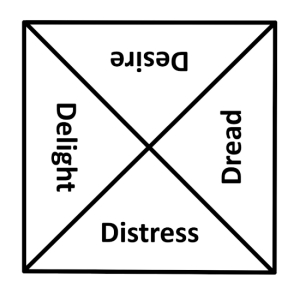 Eight days a week
Eight days a week
Is not enough to show I care
— The Beatles
No, I’m not trying to convince you that we should all change to an eight-day week, and join all the other myriad and failed attempts at calendar reform. But just look at what we have in the Gregorian Calendar: seven day weeks, months of various sizes, days of the month falling willy-nilly on random week-days, and even extra days thrown into the calendar year because of day and solar year mismatch. And the moon’s phases also have conditioned the rough size of months, without helping to show us where they occur.
Instead I’m thinking about a change in calendar representation. It all started with the diagram above showing the days of the week and the sun, moon, and planets associated with them. Ordinary calendars show weeks as seven rectangles in a row for the days of the week labeled by the days of the month. But each day looks the same, except for their place in line along the row. It’s hard to remember the dates of each day, week after week.
Having some success using the non-circular diagram to help remember the Zodiac and their houses (which is pretty old anyway), I thought I might represent each week of Sunday through Saturday as an eight-fold with a blank, with the days of the week in specific places. Since months consist of 28 days or more, four eight-folds (E) could show the bulk of the days for each month (E1 through E4). Some days might come before the first Sunday (in E0), and some days might come after the last Saturday (in E5). Sometimes E1 and E4 may be short a few days as well.
 For example, here is January 2022. By my nomenclature, E0 has just the 1st. E1 has the 2nd through the 8th, then E2 has 9-15, E3 has 16-22, E4 has 23-29, and E5 has 30-31.
For example, here is January 2022. By my nomenclature, E0 has just the 1st. E1 has the 2nd through the 8th, then E2 has 9-15, E3 has 16-22, E4 has 23-29, and E5 has 30-31.
Months may be joined end to end in a descending series, with four extra weeks (as Es) occurring here and there as need be. After all, for 7 day weeks, having 13 months of 28 days each would be ideal since 28*13 + 1 = 365. Why go to all this trouble when it is easier to look at a regular calendar? I think it is a bit easier to remember dates with this method, but I’m really just beginning with this idea. I’ll try to post a picture of February 2022 soon.
Further Reading:
https://en.wikipedia.org/wiki/Gregorian_calendar
https://en.wikipedia.org/wiki/Calendar_reform
https://en.wikipedia.org/wiki/Week
https://en.wikipedia.org/wiki/International_Fixed_Calendar
https://en.wikipedia.org/wiki/Symmetry454
https://en.wikipedia.org/wiki/Undecimber
[*13.38-*13.40]
<>

